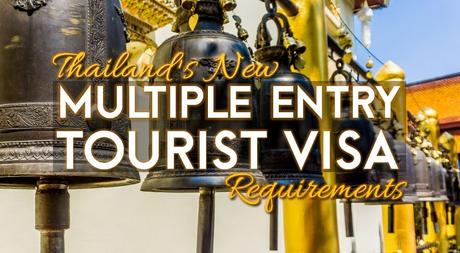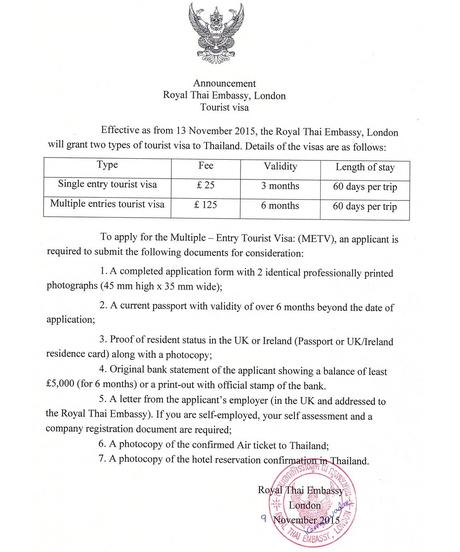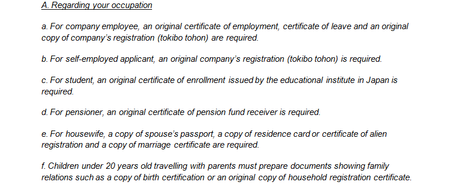
It's been several months since Thailand's newest visa officially made its debut, so now's a good a time as any to share the details about what has changed. Now that the double and triple entry tourist visas have been discontinued, here's a look at the Multiple Entry Tourist Visa requirements, its cost, and the maximum length of stay it grants its visitors.
As of 13 November 2015, Royal Thai Embassies and Consulate-Generals are no longer issuing double and triple entry tourist visas. People who have received a new double or triple entry tourist visa before 13 November 2015 are still able to use those visas until they expire (six and nine month, respectively, if you play your cards right) but this means they will be completely out of the system by August 2016.
Now, Royal Thai Embassies and Consulate-Generals are issuing the Multiple Entry Tourist Visa or METV. Visitors who want to stay in or travel to and from Thailand for more than three months but less than nine months should apply for the METV.
Here's a copy of the letter issued by the Royal Thai Embassy of London announcing the new Multiple Entry Tourist Visa requirements:

Multiple Entry Tourist Visa Requirements
Whether you see it as good or bad, the multiple entry tourist visa requirements are substantially more demanding than what was needed for the now-discontinued double or triple entry tourist visa. Keep in mind that the requirements are also subtly different based on your age, nationality, and circumstances so there is no one-size-fits-all answer. To make matters even more confusing, embassy officials are at the discretion to ask you for additional documents beyond the original list and they can reject a visa application if they find something at fault. Hey, their rules not ours!
Oh, and another doozy: you can only apply for the METV in a country of which you're either a citizen or have legal residency. That means no more short trips from Thailand to Laos for a double-entry tourist visa or traveling to one of the G7 countries for a triple-entry tourist visa. Americans can only apply in the USA, Brits can only apply in the UK, and Australians can only apply in Australia.
Passport, Photos, and Application
Make sure you have a passport that's valid for the next six months and has at least one full blank page for the new visa. Bring a photocopy of the passport photo page.
Two 2″x2″ passport photos.
Fill out a visa application form in blue or black ink. Every Royal Thai Embassy and Consulate-General have their own versions of this document so choose which location you will be applying to and either print it off from their specific website or grab a paper copy at the embassy or consulate the day you apply. The latter is easier.
The Thai tourist visa fee must be paid in the requested currency and payment type (such as cash, cashier's check, money order, or another method). It's different for every country. For example, Americans must pay 200 USD by money order and apply at a Royal Thai Embassy or Consulate-General in the USA. If you're British, you must pay 125 GPB by cash or postal order only at a Royal Thai Embassy or Consulate-General in Great Britain.
Bank Statement
Many people were blindsided by the dramatic jump in the minimum bank account balance. Now applicants are required to show the equivalent of 200,000 THB in a bank account every month for six months for the new METV, which is ten times the amount for a single entry tourist visa. For a family (no specific number of people is given), it's double that.
Some embassies accept the most recent month's account balance as 'proof of adequate finances' and do not ask for statements for the past six months. Also the level of "officialness" of the bank statement is different across embassies; some offices accept an informal bank statement printout while others need an original bank statement or a print out with the bank's official stamp. But one thing is common: every visitor has to be able to show that they have a substantial amount of funds in a bank account.
Proof of Income / Letter of Employment
If you are working, give a guarantee letter from your employer showing proof of employment. People who are self-employed can show proof of a business license or the company's registration.
If you aren't working because you are a student, retired, receive disability, live off of investments, are a minor (20 years or younger traveling with your parents), or are a housewife/househusband, there are ways around it. Here is one example of the supporting documents that is accepted by the Royal Thai Embassy in Tokyo, Japan:

We looked at the multiple entry tourist visa requirements for ten countries and not one mentioned a specific minimum monthly income amount.
Flight Itinerary
Every embassy requires some sort of proof that you are traveling to Thailand via airplane but the specific details vary greatly on this one. Some offices vaguely say "flight itinerary" while others require the first flight into Thailand; some require both a flight entering and a flight exiting; others require flight itineraries for every time you enter and exit Thailand. None mention if bus or train travel is an acceptable method to depart from or enter into Thailand. Contact your home country's embassy directly for more details.
Hotel Reservation
Again, this is open to interpretation by the embassy to which you are applying. Sure, it says "hotel booking" but it made us wonder: Is the booking required for our first hotel stay in Thailand? The first hotel every time we re-enter Thailand? Every hotel booking during our entire time in Thailand?
We have heard of people successfully submitting a copy of their booking at their first hotel. Some embassies do not provide alternative directions if you are staying somewhere such as at a friend's house or short-term apartment rental. It's best to call your embassy and ask exactly what they want.
NOTE: If after reading the requirements above and you have specific questions about what documents to submit, call or send an email to your home country's Royal Thai Embassy or Consulate-General for the most up to date information.
How the METV Works
A METV is valid for six months from the date it is issued from a Royal Thai Embassy or Consulate-General, not from the date when you first arrive in Thailand. The processing time for a METV varies between countries and even Royal Thai Embassies and Consulate-Generals within the same country. Some take two business days, some take ten. Don't apply for it too far in advance because that will eat into your time in Thailand but don't apply for it too late or you risk missing your flight to Thailand!
During this six month time frame that the visa is valid (anytime before the ENTER BEFORE date) you can enter and leave Thailand as many times as you'd like, hence the term 'multiple-entry visa'.
Each time you leave and re-enter, you get a new 60 day entry stamp or "period of stay". When you've reached the end of each 60 day entry stamp, you can either:
1. Do a border run to leave Thailand (go the nearest border town by land or take a flight into any other country) and then re-enter Thailand and receive a fresh 60 day stamp.
OR
2. Extend it for another 30 days at any immigration office within Thailand (there's one in every province) for 1,900 THB. When these 30 days expire, do a border run 'by air' or 'by land' to obtain a fresh 60 day entry stamp when you re-enter Thailand.
Continue doing this until your METV expires, which is the ENTER BEFORE date stamped onto the visa.
'By Air' and 'By Land' Border Run Locations in Thailand
Yellow stars indicate international airports and blue stars indicate land crossings.
Keep in mind that the METV is not a continuous stay visa. In other words, you cannot stay for six months straight in Thailand; you must leave the country a minimum of once every 60 days. You can leave once every 90 days if you've obtained an extension for every "period of stay".
If you overstay an entry stamp without first extending it, the fine is 500 THB per day for a maximum fine of 200,000 THB and you will no longer be eligible to extend that particular entry. You will also be fined for overstaying the 30 day extension. Some visitors have not been fined for staying one day over and they weren't banned from future visits from Thailand. If you overstay by several months or more, there are heavy fines and you do run the risk of not being allowed back into Thailand.
You can stay in Thailand on one entry stamp up to 90 days. Since it's not longer than 90 days, you do not have to submit a "Form for Alien to Notify of Staying Longer than 90 Days" (form TM.47). When you leave Thailand and re-enter on a new entry stamp, the day count resets.
How to Stay in Thailand for (Nearly) Nine Months
Now all foreign nationals can stay in Thailand for up to nine months. It used to be that only passport holders from the G7 countries (Canada, France, Germany, Italy, Japan, UK, and USA) could do this on the old triple entry tourist visa. Other countries' citizens, such as South Africans or Australians, were only eligible for the double entry tourist visa that allotted up to a six month stay.
The first step to getting a nearly nine month stay in Thailand is to fly to Thailand immediately after your METV has been issued. Remember: the METV becomes effective the date it is issued (not when you enter Thailand for the first time) and is good for six months. If you get your METV and then wait a month before going to Thailand, you've already slashed your maximum stay down to eight months.
Here's the trick to getting nine months: As you approach the expiration date of your visa, make plans to take a small vacation or a quick border run to another country and be sure to enter Thailand the day before the ENTER BEFORE date stamped on the visa in your passport. In doing so, you will receive your final 60 day entry stamp, which can then be extended for another 30 days at any immigration office for 1,900 THB.
So 6 months (length of original METV) + 2 months (final 60 day stamp) + 1 month (final 30 day extension) = 9 months
If you plan on living in Thailand, sign up for our membership site to learn more about long-term visa options. We have detailed post on each visa type so that you can choose which is best for your situation.
Budgeting for a METV
It's easy to overlook the total cost of a METV because there are the hidden costs to maintain it. These include the money spent on border runs and in addition to visa extensions. We made this mistake ourselves when we first moved here! The extra money you spend to maintain your METV during its six month lifespan depends on:
1. How many times you leave Thailand and your accrued traveling expenses
AND
2. How many times you extend each 60 day entry stamp ("period of stay")
Every time you leave Thailand, you will have to budget for transportation, accommodation (if you spend the night anywhere), food, and any visa-related fees (if required) of other countries. This amount depends heavily on where you are staying in Thailand, what country you plan on traveling to, what method of travel you'll use, and how long you will be staying outside of Thailand before coming back in.
It's actually impossible to give an estimate because there are so many factors that can affect the overall price. However, if you're staying in Chiang Mai, we've done a cost breakdown of the cheapest border run on our membership site.
You can keep the border runs to a minimum by staying the full length of every 60 day entry stamp and then applying for an extension at the end of each these entries. Each 60 day entry stamp is eligible for one 30 day extension and costs 1,900 THB.
Due to the overwhelming number of requests for help regarding individual visa scenarios, we are not allowing comments on this post. If you have questions about your specific situation and would like to personally consult with us about your visa or travel arrangements, you can contact us and we will provide you with a quote.
Chris and Angela sold everything, paid off their debt, and ultimately figured a way out of the nine to five grind in the United States. Today they are living full time in Chiang Mai, Thailand, guiding and inspiring future expats towards amazing lives abroad! For more updates follow them on , , and . To see a full list of posts check out the .

